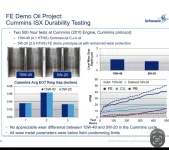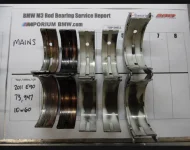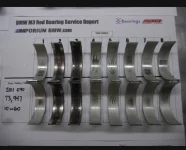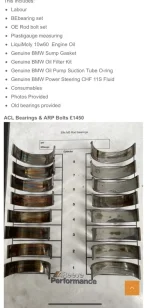You are using an out of date browser. It may not display this or other websites correctly.
You should upgrade or use an alternative browser.
You should upgrade or use an alternative browser.
0W20 for good protection?
- Thread starter CarfriendXX
- Start date
And if you own a Toyota, just make sure you follow the owners manual from Australia.follow your owners manual.......
From the top, DECADE old SAE-Lubrizol article...This was linked by @Shannow a few years back:
https://web.archive.org/web/2018080...ditive-technology-to-address-wear-challenges/
To further contribute to higher fuel economy, a reduction in the oil’s high-temperature, high-shear (HTHS) viscosity limits has also been defined in SAE 16. Set at a minimum of 2.3 mPa⋅s at 150°C, this marks the first time ever that SAE has defined this limit below 2.6. Although it will help improve fuel efficiency throughout the entire oil drain interval, it opens the door for increased wear and tear on critical engine parts. This makes the development of new additives suitable for ultra-thin oils in high power density engines that much more critical.
GF-6B, on the other hand, forgoes the requirement to be backwards compatible with GF-5 applications and opens the door for the development of ultra-low viscosity lubricants (i.e., SAE 16) that will push the industry into areas of formulation that have never before been encountered. These lubricants will produce significant fuel economy benefits for many engine applications, but because of their low viscosity grade, there is the potential for wear or other durability related issues.
When asked about the implications that SAE XW-16 will have on passenger car motor oil (PCMO) performance requirements, Lubrizol’s PCMO Product Manager, Jon Vilardo, said:
“While it is generally accepted that lower viscosity brings an improvement in fuel economy performance, it can have a negative impact on durability; the protective oil film is less robust, or under the most extreme loading conditions, non-existent. In terms of performance requirements, this translates to a set of standards that will ensure fuel economy is improved via lower viscosity, but durability will not be compromised. The future proposed ultra-low viscosity GF-6B specification requires the same durability performance as the proposed GF-6A. This may require enhanced fortification of specific additive components or a different formulation shape to deliver the required durability in SAE XW-16 fluids.”
And some more quality content from @Shannow:
https://bobistheoilguy.com/forums/threads/0w20-vs-5w30-in-1999-e46-323i.230528/page-5#post-3635354
And another Shannow quote, with a link to a few papers:
https://bobistheoilguy.com/forums/t...t-mixed-boundary-running.205309/#post-3153646
Also a good point by Solarant that Shannow was responding to.
Lots of stuff on this in the bowels of this forum, though unfortunately most of Shannow's pictures are no longer with us, I was hoping to find the snapshot of the Honda paper that talked about "acceptable wear" that kicked off many of these discussions in the past.
" The future proposed ultra-low viscosity GF-6B specification requires the same durability performance as the proposed GF-6A. This may require enhanced fortification of specific additive components or a different formulation shape to deliver the required durability in SAE XW16 fluids. "
I use an outlier oil, HPL PP 0W8, which is beyond the realm of even GF-6B. Obviously, there is absolutely no data for me to stand on. The essential cutting edge strategies, declared above, are what I rely on for anticipated positive results with this oil. The good stuff is in my 0W8.
Thus far, my UOAs appear to be trending in a good direction. Innovative, outside the box base stocks, are not mentioned, as well as very stable, albeit expensive viscosity index improvers, and they play a vital role also.
Of course would not be possible for me to respond to skewering from phds, experts and highly informed posters in this situation. Even if I were a scientist, I literally would not know...yet.
In that greater durability is a requirement of these latest SP/GF-6 oils, it would seem that we can use 0W20 when it is spec'd, and with great confidence, in that there is adequate-good-make that excellent protection.
All band aids to use low viscosity oils to please the misinformed green nuts. Cafe.Engine friction reduction, variable oil pumps and good thermal management allows safe application of low viscosity oil. Toyota's engines are well designed for such parameters.
Both Toyota and Honda failed in the thermal management department. Both the new civics R and the Yaris GR are having issues if ran hard. Supra also.
Variable oil pumps??? Yup, everything for that .001 mpg increase. Here's a secret. All oil pumps are "vatiable" . Volume increases and decreases with rpm. I swear I'm not making this up. I am well aware by what you mean by "variable" .
"Safe application" ....maybe. How about longevity. It's no secret ALL the manufacturers have a battle with that due to the green agenda pushed by nuts and politicians.
That YOU know of. Plenty have gone back, trust me.The Toyota Yaris GR has a 10-year factory warranty up to a maximum of 160,000 km in Europe and only 0w20 API SP GF-6A is approved. i think toyota is sure of its engines and so far no engine problems are known with the yaris.
Toyota was also sure of its engines in the Scions and plenty of other models that it had to replace piston rings in. Lexus models also. Also the valve trains it had to replace under warranty for the Celica GT-s.
I tell you what. You're so sure about Toyota's oil recommendations, I have a deal for you.The Toyota Yaris GR has a 10-year factory warranty up to a maximum of 160,000 km in Europe and only 0w20 API SP GF-6A is approved. i think toyota is sure of its engines and so far no engine problems are known with the yaris.
You run 50 laps of PPIR in that yaris with 20 grade oil, I'll run the same yaris with my choice of oil at PPIR FLAT OUT.
Who completes the most laps without car going into limp mode or has oil related failures, doesn't have to pay for the track rental or the Yaris. Lower pays for the winner's car and track time.
- Joined
- Dec 24, 2013
- Messages
- 614
Ford always used 5w30 in turbo engines. For year 2021 ford switched back to 5w30 in the 5.0 due to oil consumption and wear issues in timing chain guides.I’ve posted in the past the Ford went to 5w20 in 2001, more than 20 years ago. We should be asking the Ford long haulers. Another piece of info is that Ford recently went back to 5w30 for the 5.0 and the twin turbo V-6.
For the same 5.0, they recommend 5w50 for track use. We know that high RPM use increases oil temperature. That is well documented.
Yes they are sure of obtaining acceptable wear within that timeframe. If that’s what you want then you’re good to go.The Toyota Yaris GR has a 10-year factory warranty up to a maximum of 160,000 km in Europe and only 0w20 API SP GF-6A is approved. i think toyota is sure of its engines and so far no engine problems are known with the yaris.
https://www.toyota.ie/content/dam/t...s/relax/Toyota-Relax-Terms-and-Conditions.pdf
Toyota relax warranty 10 years 185.000 km. Applies to all models in Europe, including engines with 0w8 oil
Toyota relax warranty 10 years 185.000 km. Applies to all models in Europe, including engines with 0w8 oil
I don't think anyone here would agree that the sky is the limit when it comes to oil grade and wear protection.There are also many BMW engines that have bearing damage despite 10w60 oil.
Or the bottom end isn’t stiff enough and flops around like Gumby on crack playing twister… since it seems that no matter what oil or what machining is done and this is the result, I’d be more inclined to believe it’s poor design rather than an oil or bearing issue.Bmw 10w60 bearing wear. maybe too viscous or constructive deficiency
But then again I haven’t devoted tons of time into researching that engine’s problems…
Watch and learn...Bmw 10w60 bearing wear. maybe too viscous or constructive deficiency
Not too viscous.Bmw 10w60 bearing wear. maybe too viscous or constructive deficiency
Can you imagine what those bearings would look like if xW-20 was used during track days?Or the bottom end isn’t stiff enough and flops around like Gumby on crack playing twister… since it seems that no matter what oil or what machining is done and this is the result, I’d be more inclined to believe it’s poor design rather than an oil or bearing issue.
But then again I haven’t devoted tons of time into researching that engine’s problems…
I'll bet nobody running thinner oil than the specified 10W-60 sees any better bearing wear on stock bearings while keeping all other factors constant. Also, maybe guys are using 10W where it gets pretty cold and pushing the W rating to the limit or beyond, which doesn't help engine wear during very cold start-ups.
Similar threads
- Replies
- 2
- Views
- 205
- Replies
- 15
- Views
- 968
- Replies
- 46
- Views
- 4K
- Locked
- Replies
- 183
- Views
- 10K






